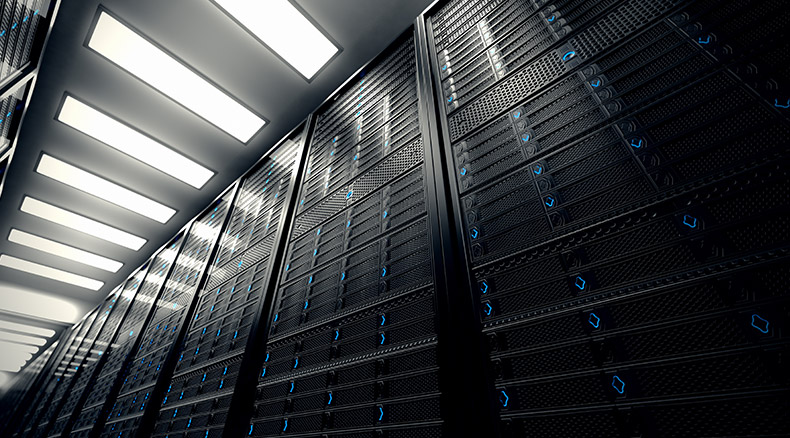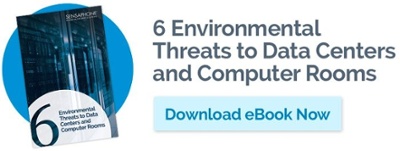
When you’re responsible for monitoring critical server equipment, issues can't wait for your attention. And these issues go beyond ensuring the health of the data itself. You need a system that can notify you immediately about high room temperatures, power outages, water damage and other issues so that you can take fast, corrective action.
Data center monitoring systems alert you to issues threatening your IT or server equipment. Whether you have a small server room or a large data center, these systems can help minimize downtime and improve the efficiency of your operation.
They notify personnel as soon as a change in environmental conditions occurs, including:
- Extreme server temperatures
- Power fluctuations
- Humidity changes
- Unauthorized access and unlawful break-ins
- Water detection
- Restricted airflow
Choosing the right data center monitoring system is crucial to protecting server rooms and network distribution facilities. Here are some key considerations you should make when looking for a solution for your facility.
Hardwired or Wireless Sensors
Remote monitoring systems are available with either hardwired or wireless sensors. In a hardwired monitoring system, the sensors are connected directly to the base unit. However, running wires over long distances can be expensive and time-consuming.
Alternatively, wireless systems use built-in radio transmitters to communicate with the base unit. These systems have no conduit requirements, so you don’t have to worry about hardwiring instrumentation. Some monitoring systems can accommodate both types of sensors.
Placement of Sensors
Sensor placement is key to ensuring accurate temperature readings in data centers. Proper placement depends on what you need to monitor. For example, a sensor placed inside a rack system won’t provide an accurate room temperature. It will only monitor the temperature within the rack.
If you are using multiple servers, computers and racks, you should install sensors throughout the room. We recommend you place sensors as follows:
- One sensor next to the thermostat controlling the room temperature
- Two sensors on the front door of each rack
- One sensor midway on the back of each rack
- One sensor for each air circulation plenum space
It’s also important to consider the position of your water detection sensors. Water and fluid leaks are a serious concern in data centers. Water tends to pool at the lowest point of the floor and underneath pipe junctions and air conditioning units. So, if you install the sensor too high, it won’t detect a flood until it’s too late.
Leak detection rope can help address this issue and prevent damage in your facility. It can be placed under the raised floor and under any pipes that carry fluids through your data center.
Alarm Notifications
When monitoring systems detect a threat to your environment, they immediately send an alert to the appropriate personnel. Using multiple communications methods ensures the alert gets through to someone — even if the network is down. Before you purchase a monitoring system, check that it offers different options for receiving alerts (email, text, phone call, etc.).
The system should also allow you to customize alarms to contact different people depending on the issue or time of day. That way, if someone is off-duty or doesn’t work in a particular department, they won’t receive an alarm. Also, take note of how many contacts the system can reach and whether or not the system will automatically cycle through the contact list until it gets a response.
Data Logging for Predictive Maintenance
Many environmental monitoring systems also function as a data logger. These systems automatically save information, allowing you to identify patterns and trends in monitored conditions. For example, if a data log shows power fluctuations occurring at regular intervals, it could indicate a more serious issue. Or if the data shows early signs of an equipment malfunction, you can resolve the issue before failure occurs.
With a cloud-based data logger, you can store an unlimited number of records. Analyzing all this data can provide insight into larger issues that may have never been detected otherwise. However, if the data logger isn't cloud-based, old data is overwritten by new data and issues may go undetected unless it is downloaded and stored elsewhere.
Real-Time Status Checks
Monitoring data centers manually is inefficient and prone to error. That’s why you need a remote monitoring system that provides real-time status of all monitored conditions. There are many different ways to check environment status using these systems. You could call in to check status, log in remotely via a web browser or use the mobile app.
With a cloud-based system, you can monitor conditions from anywhere and at any time. If you don’t use a cloud-based monitoring system, you will have to log in through a local area network to make programming changes, access status conditions and review data logs.
Data center monitoring is crucial to running an efficient operation. The right system will provide immediate and detailed insight to prevent costly downtime. For more information, contact us today or read How To Select The Right Monitoring System For Your Data Center for other factors to consider.








